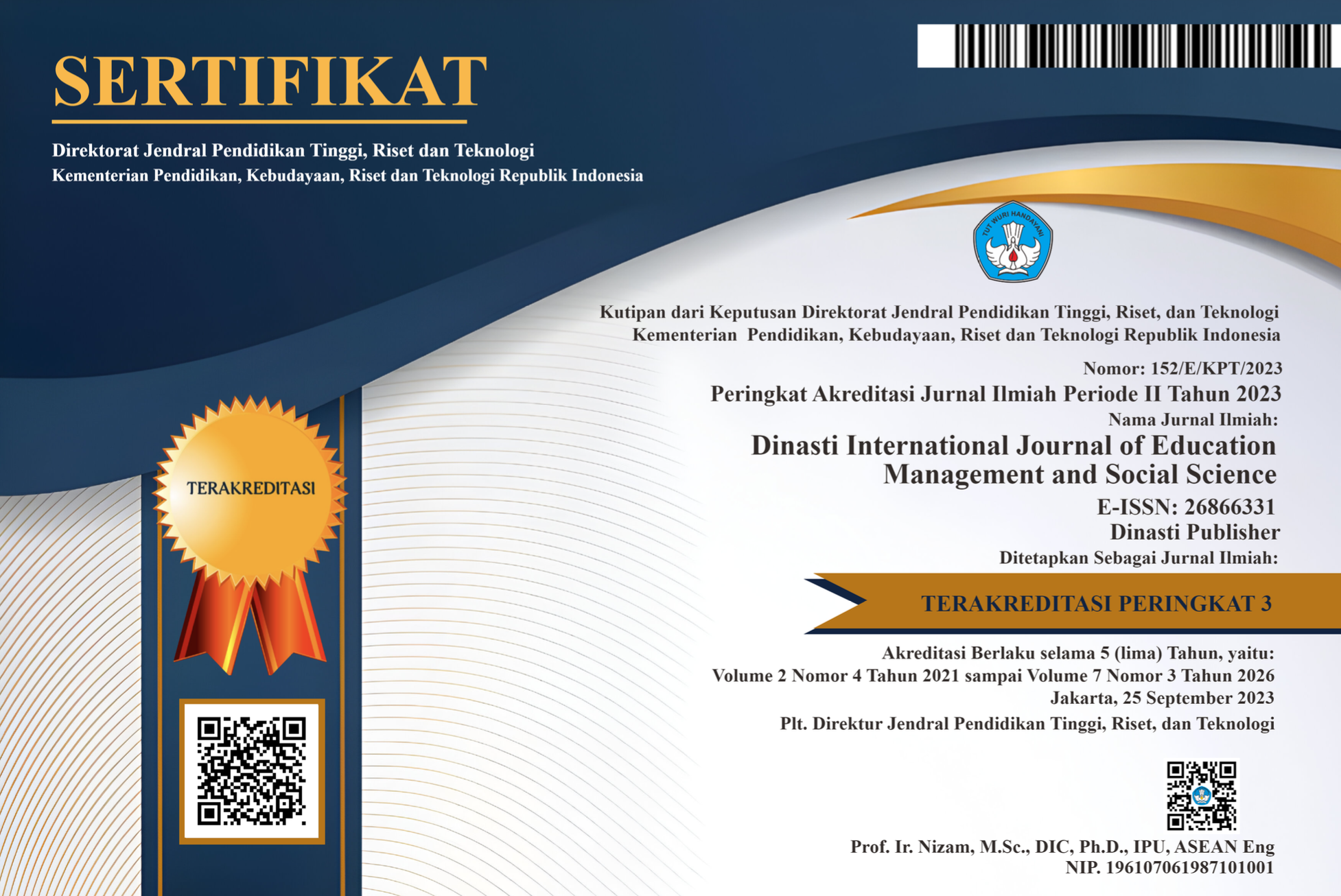The Implementation of Impromptu Speaking Method at Bilingual Boarding School
DOI:
https://doi.org/10.38035/dijemss.v6i5.4584Keywords:
Implementation, Impromptu speaking method, Speaking skillsAbstract
This study explored the implementation of the impromptu speaking method in a bilingual learning environment at 10th Graders of MA Al-Musyaffa’ Semarang. The research aims to describe the assessment and the effectiveness of this method followed by the students’ perception toward this method. This study employed quantitative approach. The data were collected through pre-test and post-test, questionnaires, and documentation. The findings revealed that the assessment focused on fluency, vocabulary, pronunciation, and comprehension, with average students' pretest and posttest scores improving from 65.75 to 83.26. Furthermore, statistical analysis using SPSS Version 26 confirmed the effectiveness of this method, with a significant improvement in students' speaking skills (????-count = 7.671 > ????-table = 2.110, significance value = 0.00). The findings indicated a highly significant impact across all the speaking skill aspects. Additionally, students’ perceptions of the implementation of impromptu speaking method were categorized into positive and negative perceptions, comprised into personal, pedagogical, and activity-related factors.
References
Andrin, G., Kilag, O. K., Abella, J., Tañiza, F., Groenewald, E., & Cordova Jr, N. (2024). Innovative pedagogy: The influence of impromptu speaking on students’ english oral proficiency. Excellencia: International Multi-Disciplinary Journal of Education (2994-9521), 2(1), 36–46.
Barruansyah, R. T. (2018). Applying impromptu speech technique to improve students’ speaking ability at the fourth semester students of STIBA Persada. J-SHMIC: Journal of English for Academic, 5(2), 57–72.
Baurain, B. (2011). Teachers, Learning and Generative Silence. Journal of Curriculum Theorizing, 27(3).
Bytwerk, R. L. (1985). Impromptu speaking exercises.
Ceneciro, C. C., Estoque, M. R., & Chavez, J. V. (2023). Analysis of debate skills to the learners’ confidence and anxiety in the use of the English language in academic engagements. Journal of Namibian Studies: History Politics Culture, 33, 4544–4569.
Creswell, J. W. (2015). Educational research: Planning, conducting, and evaluating quantitative and qualitative research. pearson.
De Jong, N. H. (2023). Assessing second language speaking proficiency. Annual Review of Linguistics, 9(1), 541–560.
Dobson, J. M. (1981). Effective techniques for English conversation groups. English Teaching Division, Educational and Cultural Affairs, International ….
Fauzan, U. (2014). The use of improvisations technique to improve the speaking ability of EFL students. Dinamika Ilmu, 14(2), 264–287.
Fernando, W. S. A. (2020). Strategic Impromptu Speaking to Combat Anxiety and Develop a Public Speaking Personality.
Fredricks, S. M. (2005). Teaching impromptu speaking: A pictorial approach. Communication Teacher, 19(3), 75–79.
Girardelli, D. (2017). Impromptu speech gamification for ESL/EFL students. Communication Teacher, 31(3), 156–161.
Goh, C. C. M., & Burns, A. (2012). Teaching speaking: A holistic approach. Cambridge University Press.
Harmer, J. (2008). How to teach English (Vol. 62, Issue 3). Oxford University Press.
Husna, L., Astria, W. J., & Shelinda, P. (2022). A Study Of Students’ Skill In Performing Impromptu Speech In English Department At The Third Semester Of Fkip Universitas Ekasakti Padang. J. Pendidik. Tambusai, 6(2), 11630–11635.
Kayi, H. (2006). Teaching speaking: Activities to promote speaking in a second language. The Internet TESL Journal, 12(11), 1–6.
Kleiser, G. (1920). Successful Methods of Public Speaking. Binker North.
Leong, L. M., & Ahmadi, S. M. (2017). An Analysis of Factors Influencing Learners’english Speaking Skill.
Marcellino, M. (2005). Competency-based language instruction in speaking classes: Its theory and implementation in Indonesian contexts. Indonesian JELT: Indonesian Journal of English Language Teaching, 1(1), 33–44.
Masfufah, S. (2020). The Influence of Impromptu Speech Technique Towards Students’speaking Ability at The First Semester of Eleventh Grade of Sman 01 Tulang Bawang Tengah in The Academic Year of 2019/2020. UIN Raden Intan Lampung.
Miranda, M. (2018). The Implementation of Impromptu Speech to Improvestudents’ Speaking Skill (An Experimental Study at the First Year Students of MAS Al-Manar Aceh Besar). UIN Ar-Raniry Banda Aceh.
Nawi, R. A., Yasin, B., & Champion, I. C. R. (2015). Impromptu: great impromptu speaking is never just impromptu. Studies in English Language and Education, 2(2), 144–157.
Pike, C. E., & Raymundo, J. L. (2024). Public Speaking Classroom Anxiety and Oral Language Performance of Senior High School Students. International Journal of Linguistics, Literature & Translation, 7(7).
Rahmah, S. (2022). The Use of Scaffolding Talk Technique in Teaching English Speaking. UIN Ar-Raniry Banda Aceh, Tarbiyah dan Keguruan.
Richards, J. C., & Rodgers, T. S. (2014). Approaches and methods in language teaching. Cambridge university press.
Sedniev, A. (2012). Magic of Public Speaking: A Complete System to Become a World Class Speaker. Andrii Sedniev.
Sekkal, K. (2020). Impromptu speech for strengthening tertiary students’ oral communication competencies in large classes. International Journal of English Literature and Social Sciences, 5(3), 574–581.
Tamonob, A. H. (2015). Students’ Fear towards Impromptu Speech Activities in Speaking Class at the English Department of Satya Wacana Christian University. Doctoral Dissertation, Program Studi Pendidikan Bahasa Inggris FBS-UKSW.
Thompson, K. J., Switky, B., & Gilinsky, A. (2012). Impromptu presentations: Boosting student learning and engagement through spontaneous collaboration. Journal of Education for Business, 87(1), 14–21.
Wahidha, R. (2022). The Effect Of Using Impromptu Speaking Method Towards Students’ Fluency In Speaking At Eleventh Grade Of SMA Negeri 2 Bukik Barisan. PESHUM: Jurnal Pendidikan, Sosial Dan Humaniora, 2(1), 1–6.
Downloads
Published
How to Cite
Issue
Section
License
Copyright (c) 2025 Dewi Sofiyanatiz Zahro, Januarius Mujiyanto, Dwi Rukmini

This work is licensed under a Creative Commons Attribution 4.0 International License.
Authors who publish their manuscripts in this journal agree to the following conditions:
- The copyright on each article belongs to the author(s).
- The author acknowledges that the Dinasti International Journal of Education Management and Social Science (DIJEMSS) has the right to be the first to publish with a Creative Commons Attribution 4.0 International license (Attribution 4.0 International (CC BY 4.0).
- Authors can submit articles separately, arrange for the non-exclusive distribution of manuscripts that have been published in this journal into other versions (e.g., sent to the author's institutional repository, publication into books, etc.), by acknowledging that the manuscript has been published for the first time in the Dinasti International Journal of Education Management and Social Science (DIJEMSS).















































